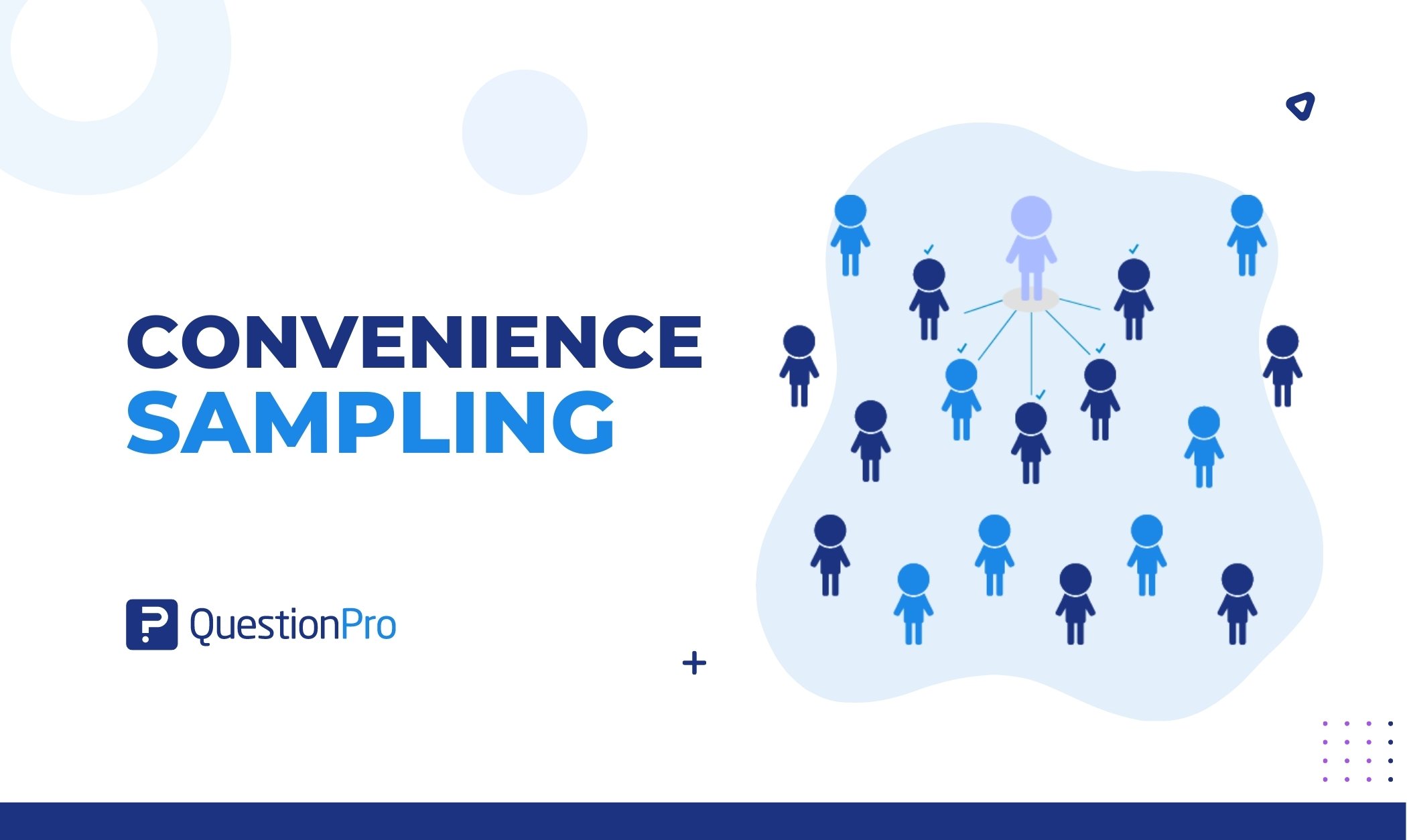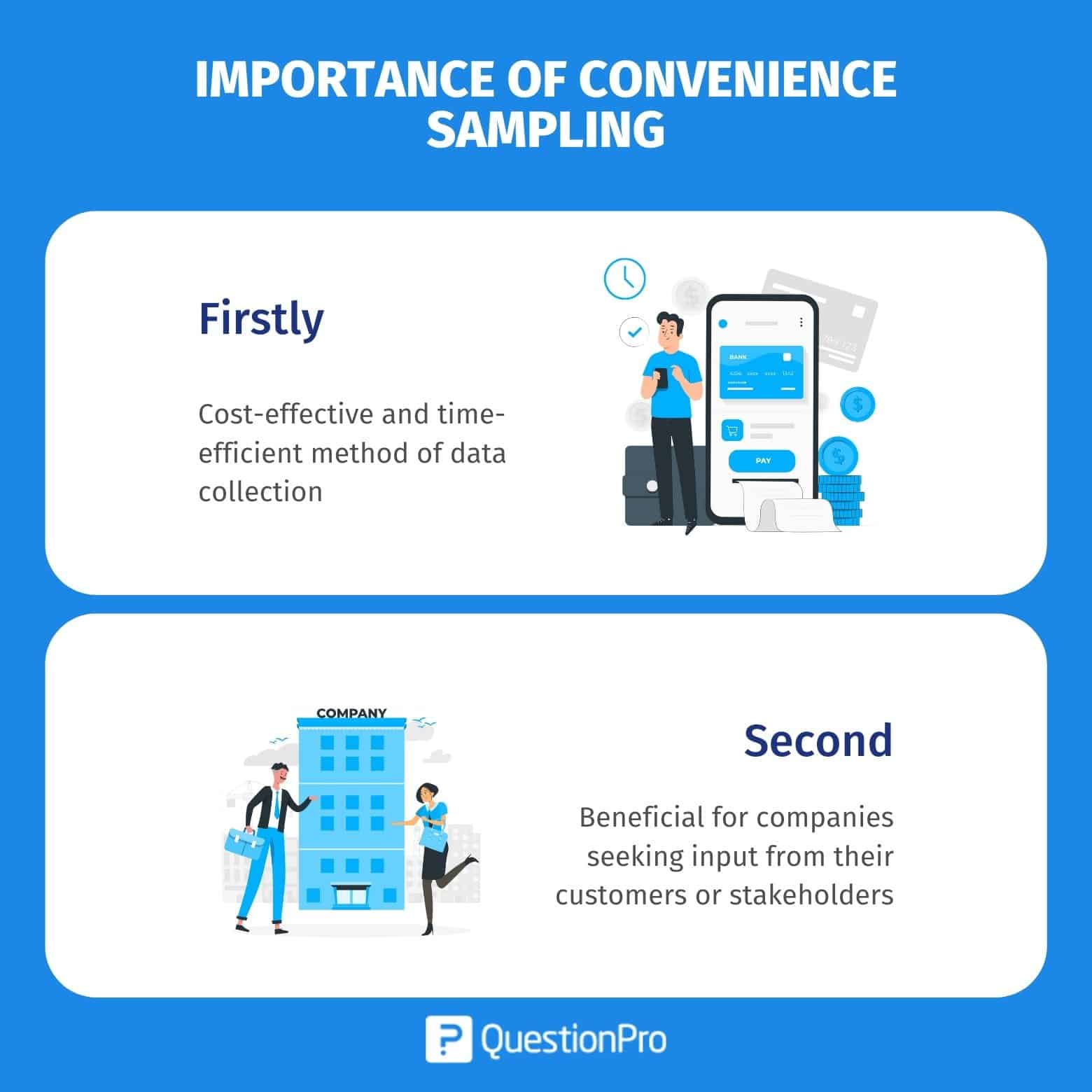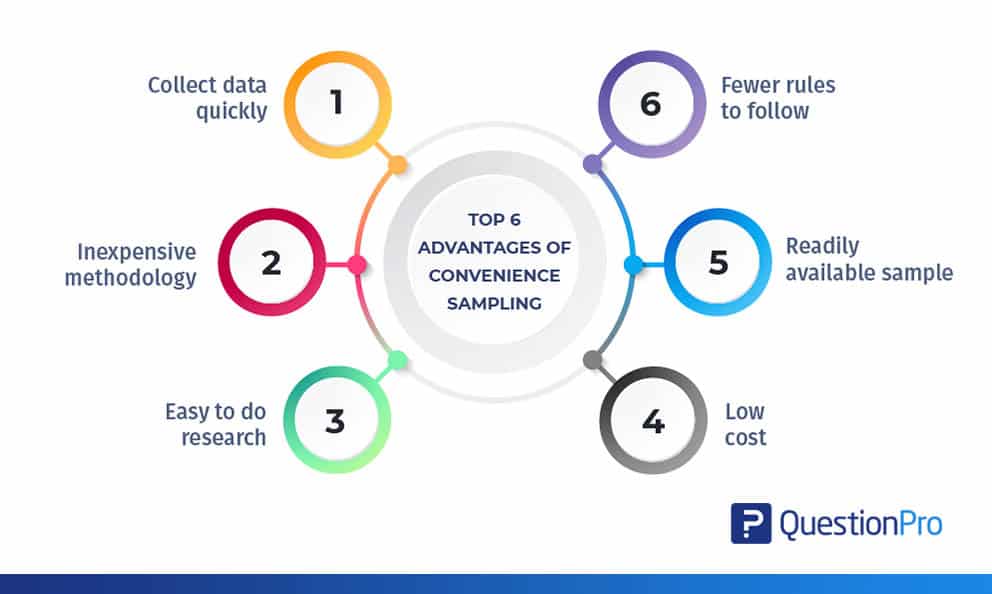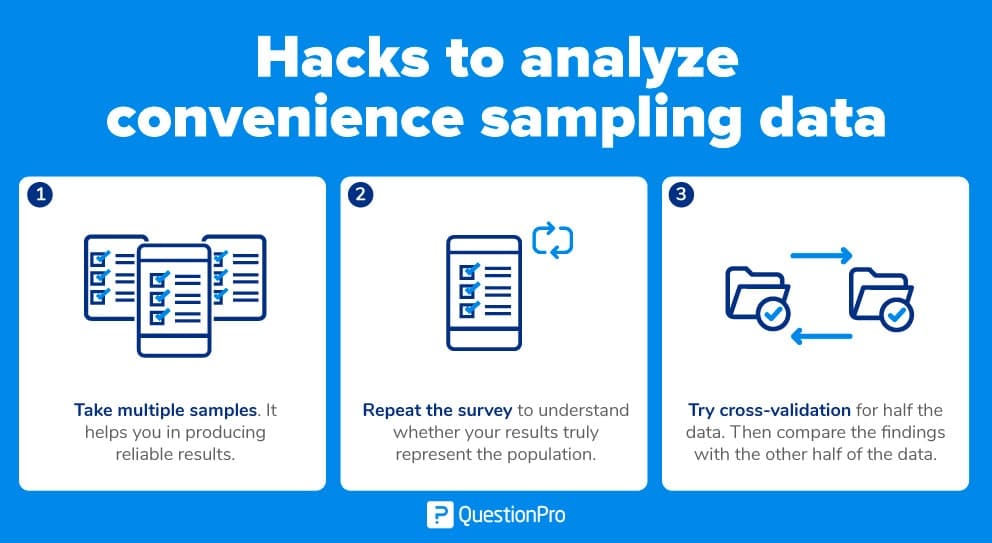
Convenience sampling is a simple and easy way to get information compared to other sampling methods. Most of the time, simple and easy go well together. But you need to know what it is so you know when to use it and when not to.
It is a type of sampling that doesn’t depend on chance and is often used in research studies. This sampling technique involves choosing people who are easy for the researcher to reach and get in touch with.
Instead of picking people at random from a certain population, convenience sampling involves picking the people who are easiest for the researcher to get information from.
Convenience sampling is often used when other types of sampling methods are hard or impossible to use because of time, cost, or other issues. Even though it can be a quick and easy way to get data, it can also have biases and limitations that can affect how well the results can be used in the real world and how reliable they are.
What is convenience sampling?
Convenience sampling is defined as a method adopted by researchers where they collect market research data from a conveniently available pool of respondents.
It is the most commonly used sampling as it’s incredibly prompt, uncomplicated, and economical. Members are often readily approachable to be a part of the sample.
Researchers use various sampling techniques in situations where there are large populations. In most cases, testing the entire community is practically impossible because they are not easy to reach. Researchers use convenience sampling in situations where additional inputs are not necessary for the principal research. There are no criteria required to be a part of this sample.
Thus, it becomes incredibly simplified to include elements in this sample. All components of the population are eligible and dependent on the researcher’s proximity to get involved in the sample.
The researcher chooses members merely based on proximity and doesn’t consider whether they represent the entire population or not.
Using this technique, they can observe habits, opinions, and viewpoints in the easiest possible manner.
LEARN ABOUT: Survey Sampling
A good example of convenience sampling is A new NGO that wants to establish itself in 20 cities. It selects the top 20 cities to serve based on the proximity to where they’re based.
Importance of convenience sampling
Convenience sampling is beneficial to businesses in a variety of ways.

- Firstly, it can be a cost-effective and time-efficient method of data collection. Businesses can save time and money by picking readily available participants instead of employing more elaborate sampling procedures.
- Secondly, it can be beneficial for companies seeking input from their customers or stakeholders. Businesses can gain useful insights and feedback by selecting individuals who have interacted with the firm or used its products/services.
It is important to highlight that convenience sampling has limits and biases that can affect the reliability and generalizability of the findings.
As a result, before depending on this sampling technique to make crucial decisions, organizations must carefully analyze the potential biases and limits.
Applications of convenience sampling:
Convenience sampling is applied by brands and organizations to measure their perception of their image in the market. Data is collected from potential customers to understand specific issues or manage opinions of a newly launched product. In some cases, it is the only available option.
For example, a university student working on a project and wants to understand the average consumption of soda on campus on a Friday night will most possibly call his/her classmates and friends and ask how many cans of soda they consume. Or may go to a party nearby and conduct an easy online survey.
There is always a chance that the randomly selected population may not accurately represent the population of interest, thus increasing the chances of research bias.
Example of convenience sampling
A basic example of a convenience sampling method is when companies distribute their promotional pamphlets and ask questions at a mall or on a crowded street with randomly selected participants.
Businesses use this sampling technique to gather information to address critical issues arising from the market. They also use it when collecting feedback about a particular feature or a newly launched product from the sample created.
During the initial stages of survey research, researchers usually prefer using this as it’s quick and easy to deliver results. Even if many statisticians avoid implementing this technique, it is vital in situations where you intend to get insights in a shorter period or without investing too much money.
For instance, a marketing student needs to get feedback on the “scope of content marketing in 2020.” The student may quickly create an online survey, send a link to all the contacts on your phone, share a link on social media, and talk to people you meet daily, face-to-face.
What is convenience sampling in qualitative research?
Convenience sampling is a qualitative research sampling strategy that involves selecting participants based on their accessibility and availability to the researcher. Rather than being drawn at random from a bigger population, participants in this strategy are picked because they are easily available to the researcher.
LEARN ABOUT: Qualitative Interview
It is frequently used in qualitative research because it can be a cost-effective and time-efficient way to collect data from individuals who are difficult to reach or may not be interested in participating in the study. Also, you can discover a wealth of insights in our latest article, showcasing diverse examples of qualitative data in education.
Learn About: Qualitative Research Questions and Questionnaires
For example, a researcher conducting a study on cancer survivors’ experiences may choose to recruit volunteers using social media groups or cancer support networks because they are easily accessible and likely to be interested in the study.
Convenience sampling in qualitative research can also contribute to data biases because the sample may not be representative of the greater community or may be prejudiced towards participants with certain qualities or experiences.
While evaluating the findings of their study, researchers must carefully evaluate the various limits and biases of this sampling strategy.
LEARN MORE: Population vs. Sample
Advantages of using convenience sampling
Here are the advantages of adopting a convenience sampling approach:

- Collect data quickly
In situations where time is a constraint, many researchers choose this method for quick data collection. The rules to gather elements for the sample are the least complicated in comparison to techniques such as simple random sampling, stratified sampling, and systematic sampling. Due to this simplicity, data collection takes minimal time. - Inexpensive to create samples
The money and time invested in other probability sampling methods are quite large compared to convenience sampling. It allows researchers to generate more samples with less or no investment and in a brief period. - Easy to do research
The name of this surveying technique clarifies how samples are formed. Elements are easily accessible by the researchers so collecting members for the sample becomes easy. - Low cost
Low cost is one of the main reasons why researchers adopt this technique. When on a small budget, researchers – especially students, can use the budget in other areas of the project. - Readily available sample
Data collection is easy and accessible. Most convenience sampling considers the population at hand. Samples are readily available to the researcher. They do not have to move around too much for data collection. Quotas are met quickly, and the data collection can commence even within a few hours. - Fewer rules to follow
It doesn’t require going through a checklist to filter members of an audience. Here, gathering critical information and data becomes uncomplicated. For instance, if an NGO wants to survey women’s empowerment, they can go to schools, colleges, offices, etc., in their proximity and gather quick responses.
Disadvantages of convenience sampling
Convenience sampling includes a number of drawbacks that can reduce the reliability and validity of research findings. The following are some of the major drawbacks:
- Bias in sampling
When participants are not chosen at random from a larger population, this might result in sampling bias. This indicates that the sample may not be typical of the greater population, and the findings may not apply to other groups. - Lack of variety
Because the researcher may choose participants who are easily accessible and have comparable features, this may result in a lack of variety in the sample. This can potentially narrow the spectrum of opinions and experiences represented in the sample. - External validity is limited
It may have poor external validity due to the possibility of sampling bias and a lack of diversity. As a result, the findings may not apply to different locations or populations. - Unknown errors
Convenience sampling can lead to unknown errors since the researcher may be unaware of how skewed or unrepresentative the sample is of the population. - Possibility of researcher bias
Researchers may be more prone to select participants who they believe would offer data that supports their theory, perhaps contributing to researcher bias.
While it can be a valuable and cost-effective method of data collection in some contexts, it is crucial to understand its limitations and inherent biases. When selecting to utilize it in their research, researchers should carefully assess its advantages and disadvantages.
How to reduce bias in convenience sampling?
The best way of reducing bias in convenience sampling is to use it along with probability sampling. Since it is usually biased, probability sampling gets the measurement parameter with it to keep this sampling bias under check.
After receiving a fair idea about this bias using probability sampling, the researcher can use both convenience sampling and probability sampling techniques to draw a more accurate estimation. The probability aspect used, along with the convenience sample, will have to be powerful enough to overcome it.
Bias can make the entire sample futile, which is the last thing a researcher needs. This bias can be reduced or eliminated by including probability sampling.
How to efficiently analyze convenience sampling data?
Here are three quick hacks to efficiently analyze convenience sampling data. It is best to use probability sampling, but when that is not possible, here are three hacks you should keep in mind.

- Take multiple samples. It helps you produce reliable results.
- Repeat the survey to understand whether your results truly represent the population.
- For a big sample size, try cross-validation for half the data. Then compare the findings with the other half of the data.
Conclusion
Convenience sampling is a non-probability sampling method in which the sample is chosen based on how easy it is for the researcher or how many people are available to participate. Even though it has some benefits, like being cheap and quick, it also has a lot of research problems, like sample bias and the inability to generalize.
A convenience sample can be helpful in some situations, but it’s important to know its possible drawbacks and use it in the right way. When choosing a sampling method, researchers should always consider the research question, population, and how the study is set up. You can use single ease questions. A single-ease question is a straightforward query that elicits a concise and uncomplicated response.
It can be helpful in research, but it shouldn’t be the only way to get samples. Combining multiple sampling techniques, such as random sampling, stratified sampling, or systematic sampling, can help improve the quality and representativeness of the convenience sample, which can lead to more accurate and reliable research outcomes.
QuestionPro offers analytics and reporting tools that work in real-time, making it easy for researchers to look at their data and find patterns and trends quickly.
Researchers can speed up the process of collecting data and ensure that their convenience sample is as representative and fair as possible by using QuestionPro. This can lead to more accurate and reliable research results, which can help guide and improve decision-making in many industries and sectors. So try QuestionPro now!







